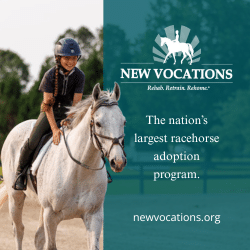‘Letdown’ for retiring Thoroughbred racehorses is more about relationship-building than a predetermined amount of time off
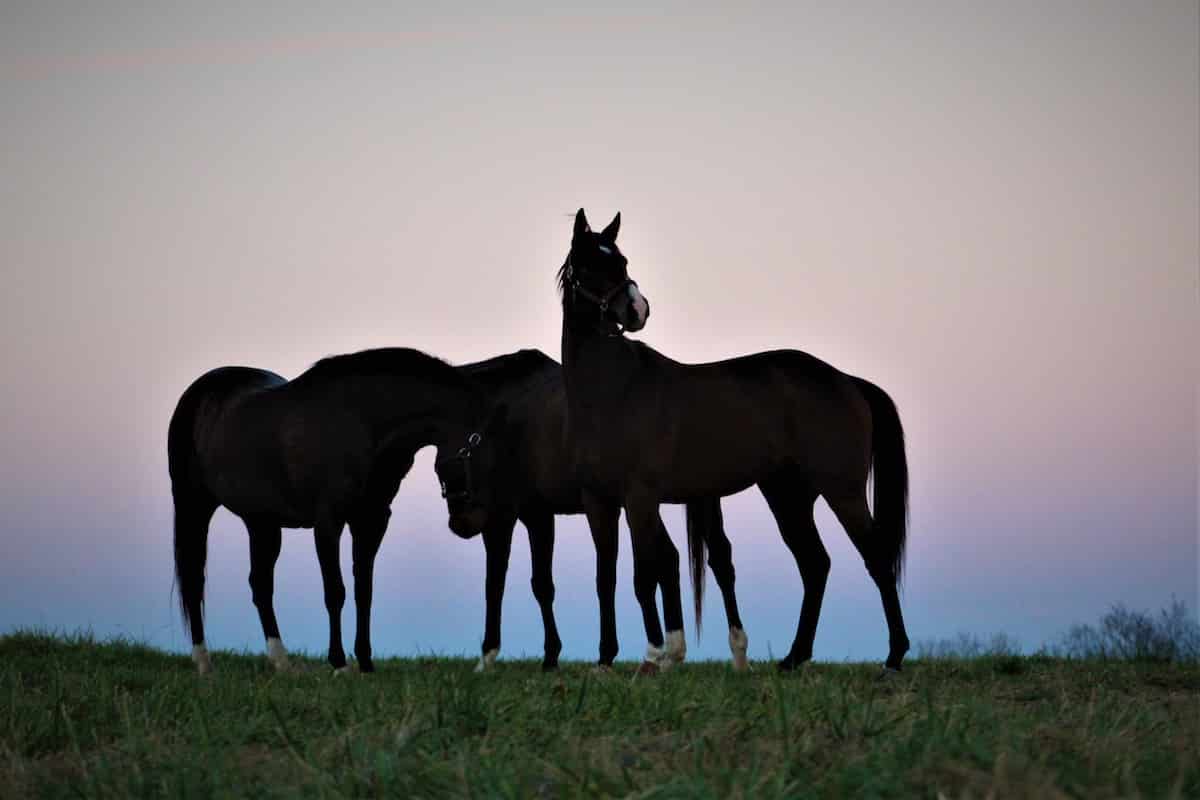
Courtesy Jen Roytz
It used to be that trainers and riders would give their newly retired Thoroughbred racehorses up to a year or more off before beginning their post-track training. It was just how you did things: Turn the horse out, let him relax and reset his mind for a new path.
Letdown time looks different these days. Arguably, our 21st-century lives move at a different pace, and board and other management costs are expensive. Plus, there are competitions to prepare for in that first year — the RRP’s Thoroughbred Makeover, for instance — that increase recently retired racehorses’ visibility and resale value.
Also, for most horses, barring injury, unfettered vacation time simply doesn’t make sense. Many trainers have found Thoroughbreds want to stay in work, and most horses benefit from keeping the condition they have coming off the track, not losing it and having to rebuild. All the while, it’s possible to achieve that relaxation and reset.
All trainers consider letdown time, no matter their primary discipline, and they have many opinions on how it should look. We spoke to three trainers about their approaches. Even though they ride in different arenas, all focus a portion of their business on OTTBs and share many of the same sentiments about transitioning the sensitive, stalwart retiring racehorse.
First Steps
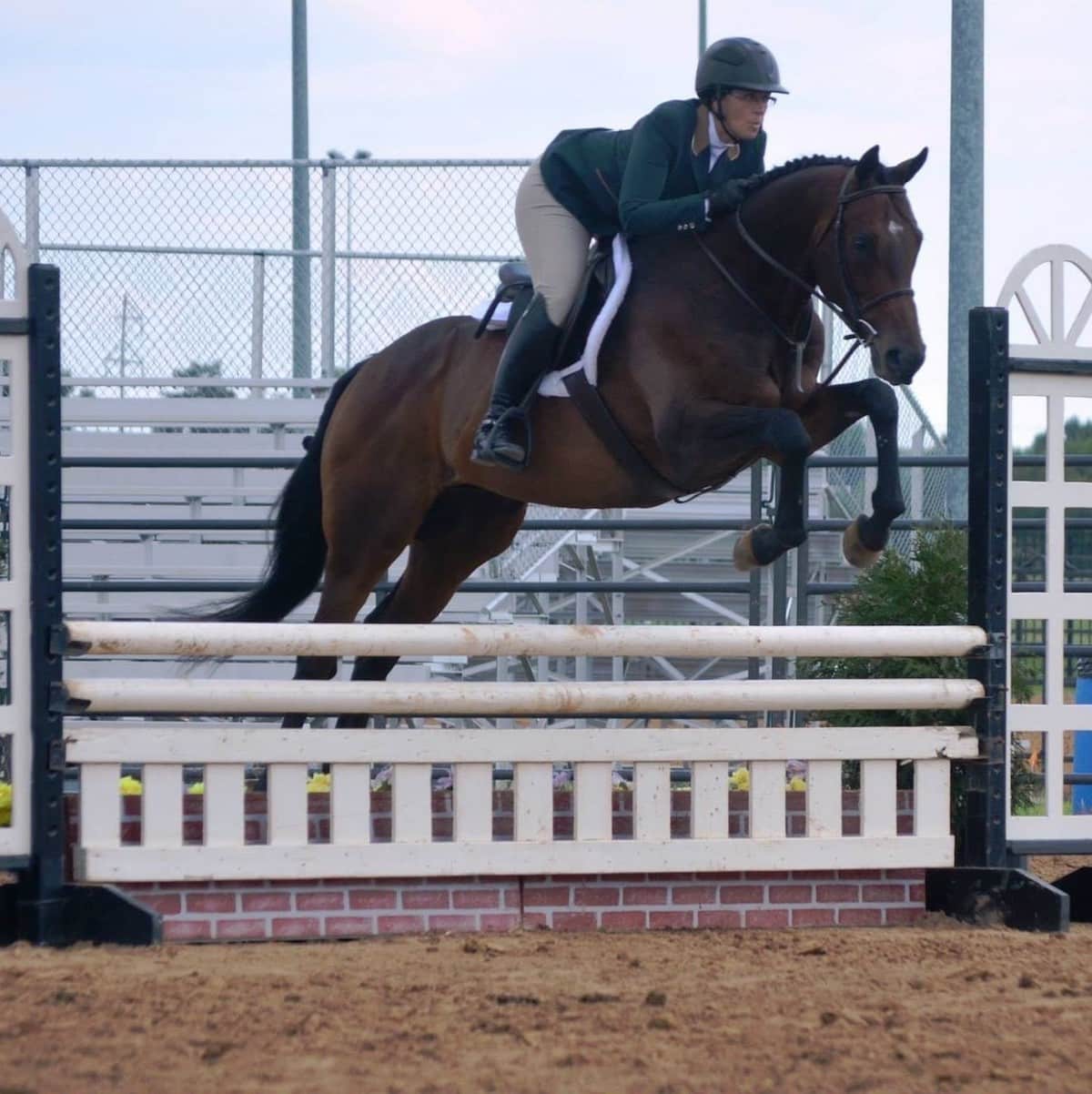
When Makeover veteran Luanne Johnson brings a new OTTB home, she lets him dictate his letdown path. Lisa Flynn Photo courtesy Luanne Johnson
Luanne Johnson, a hunter-jumper trainer who owns Willow Springs Equestrian, in Doswell, Virginia, has transitioned 50-plus OTTBs. She’s competed in two Thoroughbred Makeovers with three mounts and is working with a couple of hopefuls she plans to point toward the 2021 mega-Makeover. Thoroughbreds make up not only most of her sale and show horse string but also her lesson mounts.
“Many years back, we used to give them a lot of time off,” says Johnson. “But I found it’s better to judge it on the horse as an individual. Because they’re used to working all their lives … some of them, when you pull them off (the track), tend to get themselves in trouble,” getting injured in the field, for instance, because of their curious minds and busy bodies.
When Johnson brings a new OTTB home, she lets him dictate his letdown path. First he gets used to the barn; some horses take a day to acclimate, others take a couple of weeks. She spends a lot of time with him on the ground, grooming him leisurely, establishing personal space (if a horse is pushy and needs boundaries) and calmly leading him. She also hops on him to hack around.
“I won’t even try a ring for a while, just to give them some time to relax and decompress,” she says.
Meanwhile, she tends to body soreness or any other physical issues the horse might have, working closely with a veterinarian and equine chiropractic and massage professionals to iron out issues early in the transition process. She also addresses nutrition, gradually shifting horses to a more forage-based diet, adding high-quality alfalfa and backing off the concentrate — most horses simply don’t need all that sugar. She warns that there’s a tipping point for about a month where the horse’s body changes, and you might worry that you’ve done something wrong. When that happens, she says, just continue meeting the horse’s nutritional needs and ride it out; you’ll be rewarded soon when his post-track physique begins to appear.
All the while, a transition to turnout is mandatory. Pasture supports good gastrointestinal health, and it helps OTTBs, mentally and physically, to get out and move their bodies.
Taylor Phillips, a barrel racing trainer, begins turning her OTTB prospects out after about a week of stabling and hand-walking, eventually working up to them spending 75% of their time in the field.
Phillips, who works in the service department of a car dealership 50 hours a week, trains in her free time out of her farm in Sperry, Iowa. She is pointing two horses at the 2021 mega-Makeover. When she transitioned Mighty Vision (Pollard’s Vision — Wild Karen, Wild Tale), her 2021 hopeful, to pasture, “Valiant” ran joyous laps around the enclosure, then stood in the run-in part of the barn, then returned to running laps, eventually settling in the run-in and not quite understanding why she wasn’t back in the stall.
“I think that’s one of the biggest things,” Phillips says, “just learning to enjoy life and not be cooped up all the time.”
Eric Dierks, who trains at Stonehenge Farm in Union Grove, Wisconsin, says to watch the horse closely for signs of progress during this initial adjustment period. Long-listed for the 2002 World Equestrian Games, in Jerez, Spain, and short-listed for the 2004 Athens Olympic Games, Dierks has trained many eventers, mostly OTTBs. He approaches each prospect by “being realistic at the starting point,” not trying to fit the horse into a particular mold.
“If you want to stay sane training horses, you have to have a starting point and objective little mini goals that you can measure,” he says. “And you’ll feel like you’re making progress, and that will keep you away from these ambiguous goals of making (for instance) a five-star eventer.”
Meeting those mini goals starts with simply watching the horse’s body in these early weeks. If the horse comes to Dierks on the thin side, he gives him a little time off before beginning work and looks for weight gain. This goes for the horse’s social life, too. Many racehorses have been stabled separately on the track and need to get back to relaxing and socializing with friends. He watches for progress there by looking for an increased sparkle in the horse’s eye and playtime with the other horses.
Like Johnson and Phillips, he takes his time getting to know the horse on the ground. “It’s not just turning them out, it’s the brushing, it’s the petting in between,” he says. “It’s the talking to them. All that stuff should be done in the letdown.”
When to Dive Right In
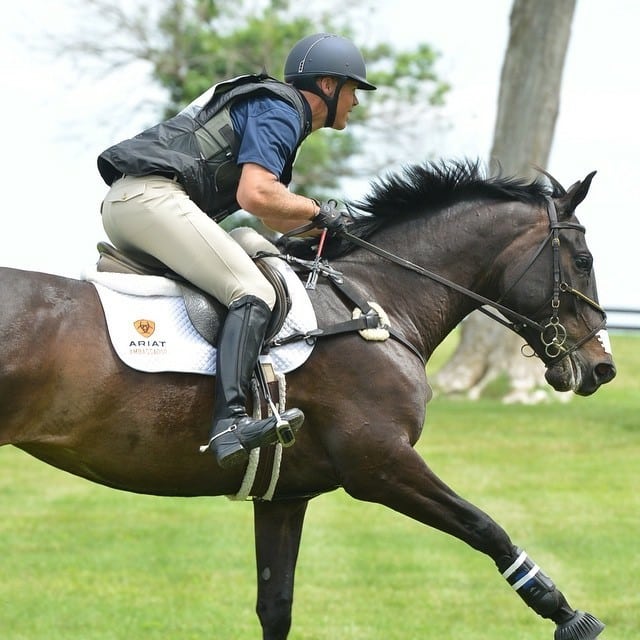
Eric Dierks doesn’t typically give OTTBs much time off: “They want to do a job and, when I lay them off long, their muscle memory just kind of goes away.” X Press Photo courtesy Eric Dierks
When to start the OTTB in work depends on the horse. Each of our trainers lets their horses prescribe the pace, looking for signs of when to move forward and when to back off.
For the most part, Dierks doesn’t give his new OTTBs much time off. “They want to do a job and, when I lay them off long, their muscle memory just kind of goes away, and you have to retrain it a bit,” he says. “I like to put them into work, but again being realistic at the starting point.”
That might be groundwork, which all three trainers use as part of their letdown regimen.
“There are some that just need that mental time of not being pressured under saddle at all,” says Johnson. “And then there are some that really crave work. (With these horses) we do a lot of things; I even introduce them to jumps on the ground, I’ll walk them over poles, I’ll walk over crossrails. I’ll walk over tarps … we will take a walk around the property — anything to keep their mind active because, you know, that was their life. They did something every day (on the track).”
All three trainers have noticed this eagerness to work, to be doing something, as a recurring theme with their OTTBs. Dierks recalls how he knew one of his current mounts, Whiskey Cures Ugly (Indian Express — Crimson, Kris S), was ready to start work.
“When I brought him home, all he did was run around the paddock; he wasn’t interested in his pals at all,” Dierks says. “He needed a job. And the more I started him on the line, and with just little minor tasks — move your hips around, move your shoulders around, back up, come toward me — he started licking his chops, lowering his head, watching me with his ears. His brain that was so overly active about the exterior things became focused on something.
“Another horse I could see in the stall weaving, watching me, almost looking depressed if I wasn’t paying attention to him,” he adds. “I immediately had to do something with him, he needed a job. Horses that take interest in some of the other horses out there, I want them to have their playtime. But this horse, he would just almost look in the corner and mope until I came out there and would give him a pat. He would go, ‘Oh, you still like me?’ ”
Other horses are simply settled, quiet and don’t need much time off. Johnson had an OTTB she describes as an old soul. “He was just laid-back as soon as he got off the trailer,” she says. “He wasn’t worried about a stall, there was no ear-pinning. And, so, the next day, I said, ‘Hey, let’s go to the ring.’ And he walked, trotted and cantered for me and went over some poles.”
When to Slow Down
Even if horses are busy and seem to want to be in work, some need to go at a more leisurely pace.
“For the ones that tend to be really nervous, I take it slow,” says Johnson. “We spend a lot of time on the ground, building that confidence in me for them and showing them there’s a right way that they can get things done and not be so stressed.”
Valiant fits this description. Phillips took the mare out for a ride in the hayfield behind the barn within a week of arrival. That first ride was relaxed, calm, uneventful. But over the ensuing months, Valiant bonded with other horses in the barn and began to worry when she left them to work.
“It takes her probably 15 minutes to get really get focused on what I’m trying to have her focus on,” says Phillips.
But she has stayed at it, quietly getting the mare’s mind engaged with groundwork and in-hand cavaletti during the requisite riding downtime (she has four rides toward the Makeover’s Dec. 1 15-ride limit) and making sure the mare is exposed to all types of activity and noise. Valiant now stands quietly eating hay at the trailer at barrel events — she goes for the experience — for hours on end, is blasé about the cacophonous dirt bike track next door and doesn’t mind Phillips’ husband’s mounted shooting. In short, she calmly exposes her horses to a lot of different stimuli.
Valentine Queen (Native Ruler — Queen of the Bayou, K One King), another of Phillips’ OTTBs, started out with similar anxiety, but her signs were more visible on the ground. “When she was standing in cross-ties, she would weave and bite the air and pin her ears at everything no matter what you were doing,” she says, “and it took probably six months for us to get past that.”
Though the mare still pins her ears from time to time and is an aloof kind of horse, she now appears to enjoy spending time with Phillips and sometimes buries her head in Phillips’ chest. “She’s like, ‘Let me do my job, I know what my job is,’ and beyond that, ‘Let me be a horse.’ ”
Phillips’ 2020 Makeover hopeful, Strip N Dippin (Discreet Cat — Carolina Blue, Victory Gallop), also needed a gradual start.
“With ‘Stripper,’ I’ve had to take things slower,” Phillips says. “She doesn’t get blown up, but she gets frustrated easily.”
Relationships Take Time
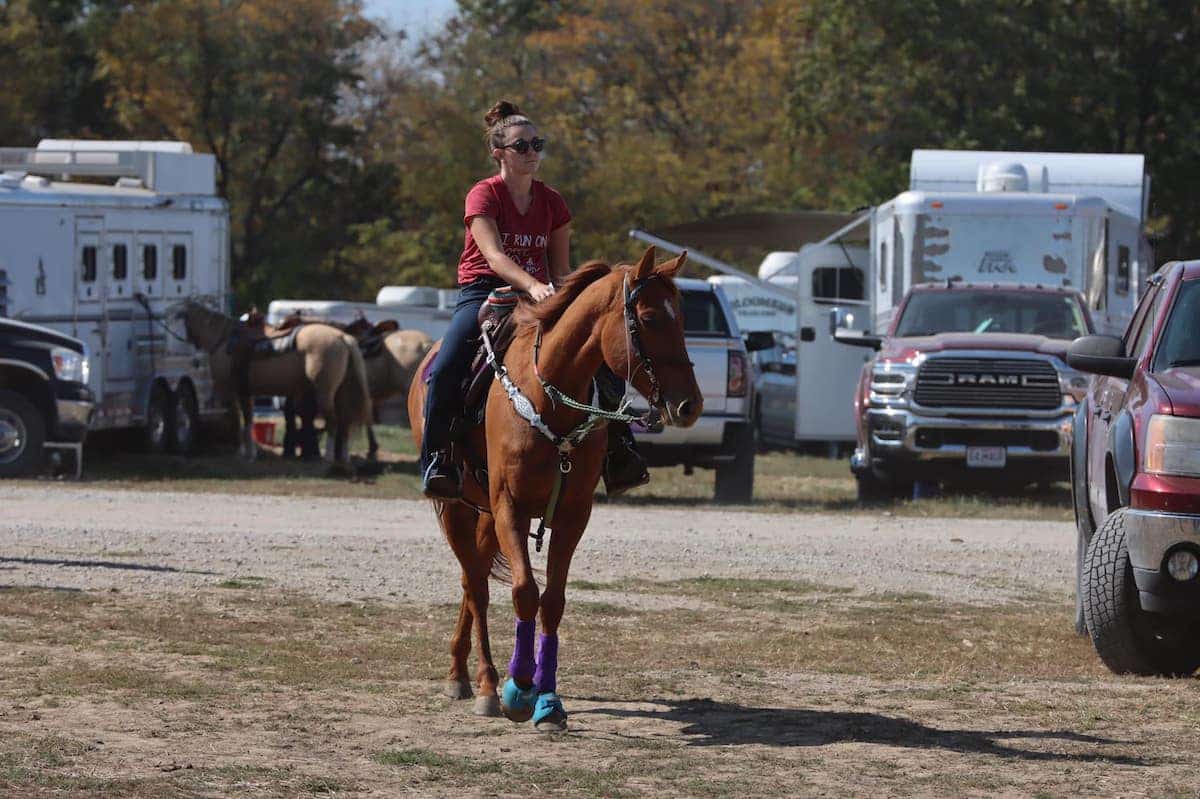
Taylor Phillips has taken things slow with her 2020 Makeover hopeful Strip N Dippin, because the mare was initially quite anxious and easily frustrated. Courtesy Taylor Phillips
The attributes Dierks enjoys most about Thoroughbreds are what direct letdown time, whether to provide it and, if so, how much.
“They’ve got enough blood, they just have a good endless source of energy, and that could be translated also into the want to work,” he says. “Their work ethic is excellent.”
Johnson agrees. “They show up,” she says. “They show up to work every day, whether they’re in a good mood or a bad mood. They’re really going to try and give me or their owner their all, in every ring.”
Cultivating the second career that springs from this vigor and drive, and timing it correctly, is an art, and ultimately our sources recommend not rushing it.
“Take some time and figure out your horse,” adds Johnson. “Spend time with him. Don’t think that, ‘Well, it’s been done this way for 100 years,’ that they all should get a year turnout. If he’s sound and if he’s happy, go with it.”
Sidebar: When Circumstances Dictate Letdown Timing
Taylor Phillips has a type: All four of her OTTBs are chestnut mares. Two are now seasoned barrel racers, and she’s pointing the other two toward the 2021 mega-Makeover.
Phillips’ day job in Sperry, Iowa, keeps her occupied 10 hours a day, five days a week. She got her first OTTB, Virtue (Lemon Drop Kid — Nobility, Lion Heart), a few Novembers ago, but due to severe winter weather — temperatures can regularly dip to -40 F — and her busy schedule, she didn’t get to start the mare on a barrel pattern until February or March.
In the meantime, she and Virtue simply got to know one another. “I like to just spend time with them in their stall, groom them,” she says, “I do groundwork and whatnot. I like them to get to where I’m their safe space.”
Thankfully, she says, she has access to an indoor arena and this winter will be keeping her two Makeover hopefuls, Strip N Dippin and Mighty Vision — in work.
Something else that orders her pace with horses? The RRP’s 15-ride limit prior to Dec. 1 for Makeover contenders.
“I’ve had Valiant now since the middle of August,” she says. “For that first week, I put a ride on her that was maybe a half-hour. But we were able to walk, trot and lope and pick up our right leads and get an idea where she was at. And then I gave her two weeks off before putting another ride on her.”
As of this writing (early November 2020), Phillips has been working on Valiant’s groundwork and looks forward to increasing her ride time come Dec. 1.

